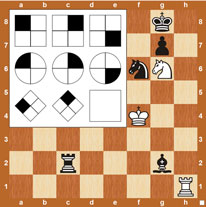

This leads us to point #2: the COVID pandemic made things much, much worse.

Still, most of them don't play enough games to close the gap between their real playing strength and the official Elo. To compensate for this phenomenon, junior players and newcomers in general rated below 2300 have a K of 40 (compared to 20 for most players and to 10 for players who were rated 2400+ at some point in their careers).

The result is that the grown-ups keep losing rating points against the bright chess prodigy, while he is not gaining them fast enough to obtain an "adequate" rating. As the adults facing him acknowledge quickly, he is much better than the rating suggests, so for them, it is by no means possible to score close to 100% against him, as the rating difference implies.

By age 8, he is rated 1500+ and starts playing open tournaments, while his real playing strength is more like 1700-1800. However, his actual rating is, in fact, only 1176 since he keeps mainly playing against his peers, who are also improving quite quickly. Since Josh works hard and smart, he keeps improving rapidly and should have been rated about 1500 by age 6. To start gaining tournament experience as early as possible, the boy plays a local event against other kids and gets an initial rating of 1038. Josh is a 5-year old kid who diligently studies chess in a club and has a great personal coach. However, in practice, this system has negatively affected both the newcomers and, particularly, the already established players. On paper, this looks like a great idea: why not allow people of all skill levels to obtain ratings and see how they compare against the world's top players? Also, this is beneficial for FIDE, as they can report a larger player pool to potential sponsors and earn some money from the players themselves. What are the main reasons for rating deflation in open events?įirst and foremost, FIDE has been gradually decreasing the rating floor. I could go on forever bringing up similar examples, but I guess you see my point already. Guess what? The underdog won the game rather effortlessly as if the ratings were reversed. These numbers were actually higher than I expected. Before the game, they started comparing their Lichess ratings in blitz, and it turned out that both of them were rated between 23 there. On the board next to me I overheard an amusing dialogue between a small kid (1784) and an experienced man (2012). Over these eight rounds, he shed 26.3 rating points, which is quite a lot for someone with a K of 10.Ī 40-year-old player from my home city rated 2147, who is considered locally to be quite strong and recently had a rapid rating of 2350+, lost a whopping 81 rating points in this tournament. I don't even think he was cheating! You see such "miracles" left and right these days, so they are not something extraordinary anymore.Īnother participant of the event, a Grandmaster aged 29 and rated 2462 who usually is quite consistent, lost in the first two rounds to players rated 19, then bounced back in a couple of games, drew a 2011, won a couple more matches, lost to a 2265 and withdrew from the tournament after Round 8. He played the opening well and fast, and all his remaining moves in the game matched the first line of Stockfish. Typically, this should have been a piece of cake for me, but this guy dispatched me quite confidently. For example, in one of the rounds of the recent Nezhmetdinov Memorial, I was paired against a 12-year-old kid rated 1747. Still, whereas a few years ago, I more or less knew how a 1700, 2000, 2300, and 2600 were supposed to play on average, now you have no idea what to expect regardless of the rating of your opponent. If you want to get somewhere else, you must run at least twice as fast as that! It takes all the running you can do, to keep in the same place.


 0 kommentar(er)
0 kommentar(er)
